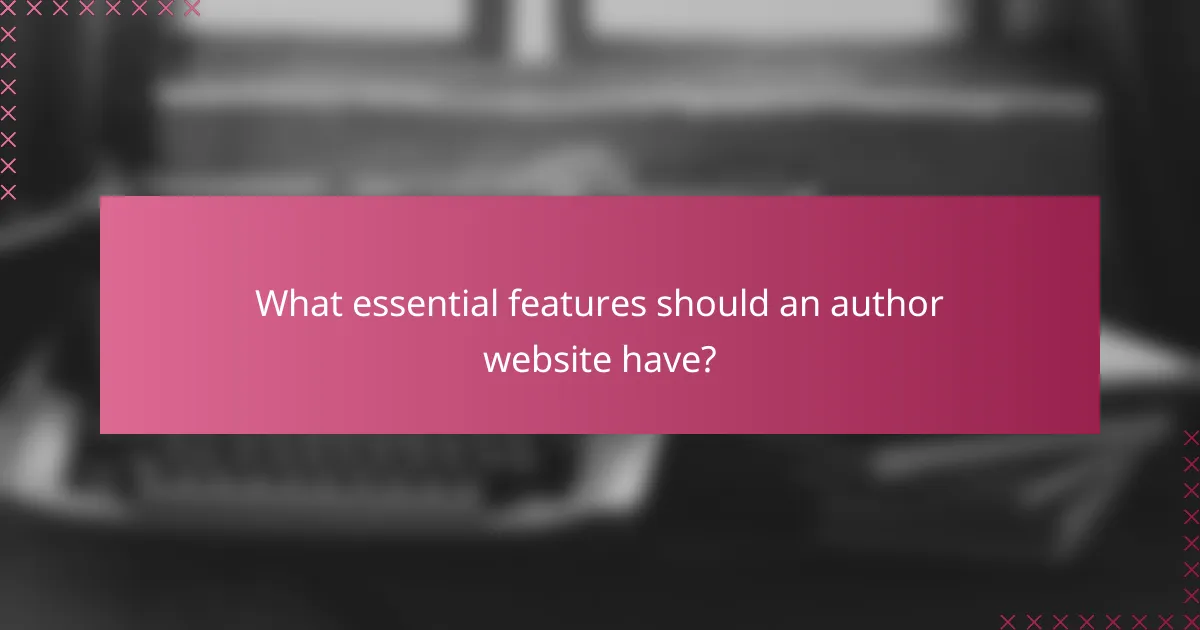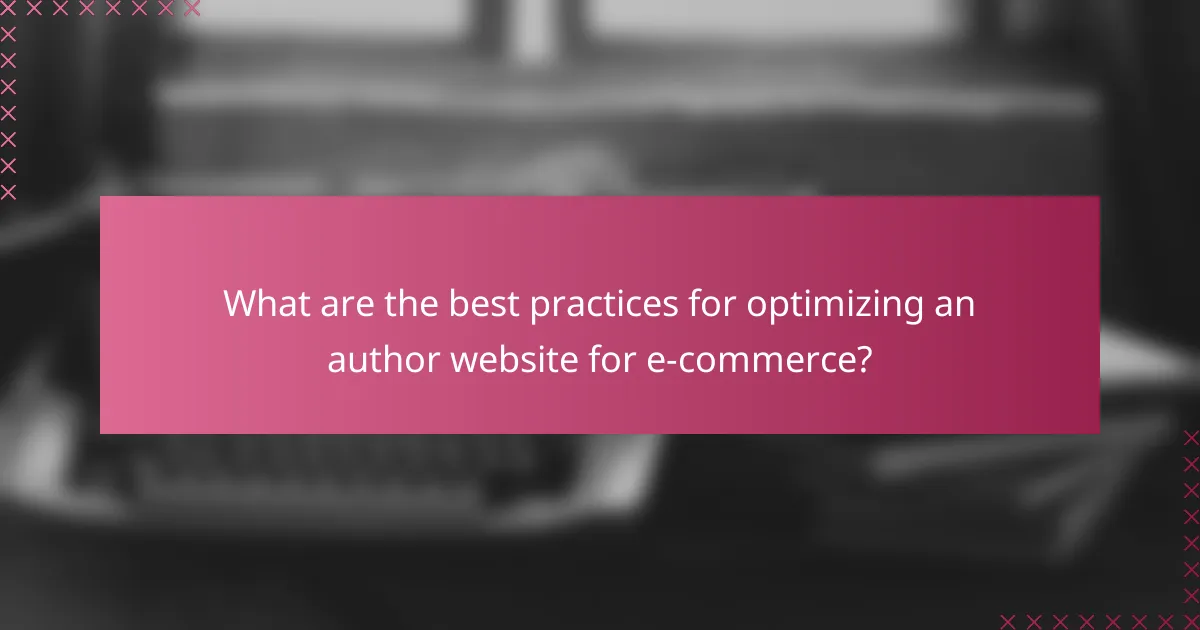An author website is a vital tool for promoting an author’s work and engaging with readers. To create an effective online presence, it should incorporate essential features such as responsive design, contact information, and interactive elements like a blog and newsletter signup. Thoughtful design enhances user experience, making the site visually appealing and easy to navigate, which can ultimately lead to increased readership and sales.

What essential features should an author website have?
An author website should include key features that enhance user experience and promote the author’s work effectively. Essential elements include responsive design, contact information, a blog section, social media links, and a newsletter signup to engage visitors and build a community.
Responsive design
Responsive design ensures that your author website looks great on all devices, from desktops to smartphones. This adaptability is crucial as more users access websites through mobile devices, and a responsive layout improves usability and engagement.
To achieve responsive design, use flexible grids and layouts, scalable images, and CSS media queries. Tools like Bootstrap or WordPress themes can simplify this process, allowing you to focus on content while ensuring a seamless experience across platforms.
Contact information
Providing clear contact information is vital for connecting with readers, publishers, and other authors. Include an email address, a contact form, and links to professional profiles to facilitate communication.
Make sure your contact details are easily accessible, ideally in the header or footer of your website. This transparency builds trust and encourages visitors to reach out with inquiries or collaboration opportunities.
Blog section
A blog section allows you to share insights, updates, and engage with your audience. Regularly posting content can improve your website’s SEO and establish you as an authority in your genre.
Consider writing about writing tips, book reviews, or personal experiences related to your work. Aim for consistent posting, whether weekly or monthly, to keep your audience engaged and returning for more content.
Social media links
Integrating social media links helps readers connect with you on various platforms, expanding your reach and fostering a community. Include icons that link to your profiles on platforms like Twitter, Facebook, Instagram, or Goodreads.
Position these links prominently on your website, such as in the header or footer, to encourage visitors to follow you. Regularly update your social media with content that complements your website to maintain engagement across channels.
Newsletter signup
A newsletter signup is an effective way to build a mailing list and keep your audience informed about new releases, events, or blog posts. Offering exclusive content or incentives, like a free eBook, can encourage signups.
Place the signup form in a visible area, such as a pop-up or a dedicated section on your homepage. Ensure compliance with regulations like GDPR by informing users how their data will be used and allowing them to opt-in easily.

How can design elements enhance user experience on an author website?
Design elements play a crucial role in enhancing user experience on an author website by creating a visually appealing and easy-to-navigate environment. Effective design can engage visitors, encourage exploration, and ultimately lead to increased readership and book sales.
Consistent branding
Consistent branding helps establish an author’s identity and builds trust with visitors. This includes using a uniform color palette, logo, and typography across all pages. For example, if an author writes thrillers, dark colors and bold fonts can evoke the right atmosphere.
To maintain consistency, create a style guide that outlines the visual elements and tone of voice to be used throughout the site. This ensures that every page reflects the same brand image, making it easier for readers to connect with the author.
Intuitive navigation
Intuitive navigation is essential for guiding visitors through an author website seamlessly. A clear menu structure with well-defined categories, such as “Books,” “About the Author,” and “Contact,” allows users to find information quickly. Consider using dropdown menus for subcategories to keep the layout clean.
Limit the number of menu items to avoid overwhelming visitors. A good rule of thumb is to keep primary navigation to five or six main items. This simplicity enhances user experience and encourages deeper exploration of the site.
High-quality images
High-quality images significantly enhance the visual appeal of an author website. Use professional photos for book covers, author portraits, and background images to create a polished look. Ensure that images are optimized for fast loading without sacrificing quality, as slow-loading pages can deter visitors.
Incorporate images that reflect the genre and themes of the author’s work. For instance, a romance author might use soft, warm colors and images that evoke emotion, while a science fiction writer might opt for futuristic visuals.
Readable typography
Readable typography is vital for ensuring that visitors can easily consume content on an author website. Choose fonts that are legible across various devices, with a minimum size of 16 pixels for body text. Pair a clean, sans-serif font for headings with a serif font for body text to create visual contrast.
Maintain adequate line spacing and contrast between text and background colors to enhance readability. Avoid using more than two or three different fonts to keep the design cohesive and professional.

What are the best practices for optimizing an author website for e-commerce?
To optimize an author website for e-commerce, focus on enhancing user experience, ensuring secure transactions, and effectively showcasing products. Implementing best practices can significantly increase conversion rates and customer satisfaction.
Clear call-to-action buttons
Clear call-to-action (CTA) buttons guide visitors toward making a purchase. Use contrasting colors and concise text, such as “Buy Now” or “Add to Cart,” to make these buttons stand out. Position them prominently on product pages and throughout the site to encourage engagement.
Consider A/B testing different button placements and wording to determine which combinations yield the highest click-through rates. Ensure that CTAs are consistent in style and messaging across the website for a cohesive user experience.
Product showcase
A well-organized product showcase highlights your offerings effectively. Use high-quality images, detailed descriptions, and engaging layouts to attract potential buyers. Group products into categories or collections to facilitate easy browsing.
Incorporate features like zoom-in functionality and 360-degree views to enhance product visibility. Additionally, consider using videos to demonstrate products in use, which can help customers make informed purchasing decisions.
User reviews and testimonials
User reviews and testimonials build trust and credibility for your e-commerce site. Encourage customers to leave feedback by offering incentives, such as discounts on future purchases. Display these reviews prominently on product pages to influence potential buyers.
Consider implementing a star rating system alongside written reviews to provide a quick visual reference for product quality. Responding to reviews, both positive and negative, shows that you value customer feedback and are committed to improving their experience.
Secure payment options
Offering secure payment options is crucial for building customer trust. Integrate widely recognized payment gateways like PayPal, Stripe, or credit card processors that comply with PCI DSS standards to ensure transaction security.
Clearly display security badges on your checkout page to reassure customers that their information is protected. Additionally, consider offering multiple payment methods to accommodate different preferences, which can help reduce cart abandonment rates.

How can authors improve website loading speed?
Authors can enhance website loading speed by optimizing various elements of their site, which directly impacts user experience and engagement. Faster loading times can lead to lower bounce rates and higher visitor retention, making it essential for authors to prioritize speed.
Image optimization
Image optimization involves reducing the file size of images without sacrificing quality. Authors should use formats like JPEG for photos and PNG for graphics with transparency, as these formats balance quality and size effectively. Tools such as TinyPNG or ImageOptim can help compress images before uploading them to the website.
Additionally, implementing responsive images that adjust to different screen sizes can further enhance loading speed. Using the srcset attribute allows browsers to select the appropriate image size based on the user’s device, improving performance on mobile devices.
Minimizing HTTP requests
Minimizing HTTP requests means reducing the number of files that a browser must download to render a webpage. Each request adds to the loading time, so combining CSS and JavaScript files can significantly speed up the process. Authors should also limit the use of external scripts and plugins that require additional requests.
Another effective strategy is to use CSS sprites, which combine multiple images into a single file. This approach reduces the number of image requests and can lead to faster loading times, especially for sites with numerous small graphics.
Using a content delivery network (CDN)
A content delivery network (CDN) distributes website content across multiple servers worldwide, allowing users to access data from a server closest to them. This reduces latency and improves loading speed, especially for authors with a global audience. Popular CDN providers include Cloudflare and Amazon CloudFront.
When choosing a CDN, consider factors such as pricing, ease of integration, and performance metrics. Implementing a CDN can significantly enhance the user experience by providing faster access to content, particularly for media-heavy websites.

What metrics should authors track for website performance?
Authors should track key metrics like page views and bounce rate to assess their website’s performance effectively. These metrics provide insights into user engagement and the overall effectiveness of content in attracting and retaining visitors.
Page views
Page views indicate how many times a specific page on an author’s website has been viewed. This metric helps authors understand which content resonates most with their audience. High page views can signal popular topics or effective marketing strategies.
To improve page views, authors can promote their work through social media, newsletters, and collaborations with other writers. Regularly updating content and optimizing for search engines can also attract more visitors.
Bounce rate
Bounce rate measures the percentage of visitors who leave a website after viewing only one page. A high bounce rate may indicate that the landing page is not engaging enough or that visitors are not finding what they expected. Authors should aim for a lower bounce rate to enhance user experience.
To reduce bounce rate, authors can improve page load times, ensure mobile-friendliness, and create compelling calls-to-action. Analyzing user behavior through tools like Google Analytics can help identify areas for improvement.
